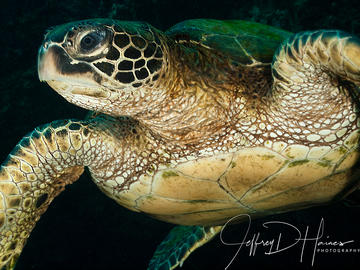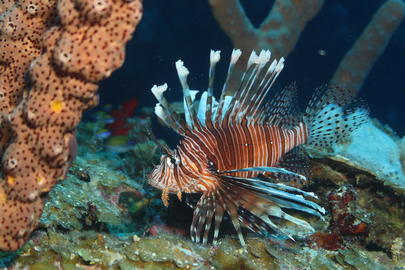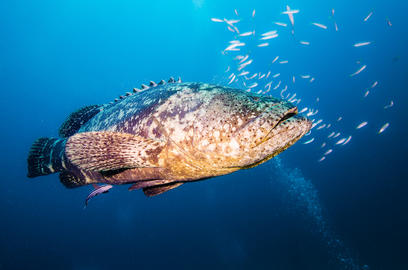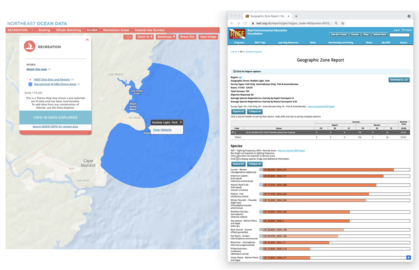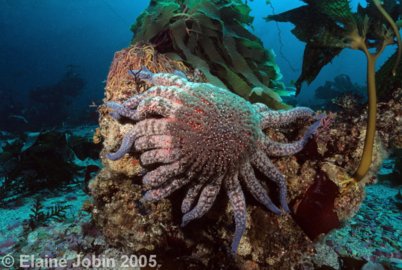The impacts of invasive lionfish (Pterois volitans/miles) on native coral reef populations in the Western Atlantic Ocean and Caribbean Sea can be enormous. However, how much lionfish differ from native predators and whether their effects outweigh the abundant mesopredators that occupy many reefs invite continued examination. The authors of this paper present empirical evidence from Caribbean Panama and beyond, suggesting that lionfish are less abundant than native mesopredators (e.g. small seabass).
Our cornerstone citizen science program is called the Volunteer Fish Survey Project, but did you know that REEF surveyors also record sea turtle sightings in all oceans? As part of this global citizen science marine life monitoring program, REEF volunteers have reported sea turtle sightings since 2001. This dataset was recently used as one of several sources of information to study sea turtles in an unexpected location, southern California.
We are excited to share a new scientific paper that was published in the journal Global Change Biology last month. Researchers used REEF’s Volunteer Fish Survey Project database to answer crucial questions about the impacts of invasive lionfish as their range expands into new areas, such as Brazil. It is well known that predation by lionfish affects native fish populations, and this impact is likely exacerbated in certain vulnerable species.
Predation by the invasive Indo-Pacific lionfish impacts native fish populations within the Caribbean region and threatens to expand further into Brazil and the Mediterranean. Identifying the range-restricted native fish species with high predation vulnerability in these areas ahead of the invasion front combined with the knowledge of the time a lionfish population typically takes to reach dangerously high densities could help conservation planners attain positive outcomes and reduce biodiversity loss.
This paper evaluates population trends in Giant Pacific Octopus (GPO) in the Pacific Northwest using REEF Volunteer Fish Survey Project data and other data sources. The authors found large changes in GPO abundance linked to average water temperatures. GPO sighting frequencies ranged from a high of 39% to a low of 11%. For every additional degree increase of 4-year average temperatures, the Puget Sound GPO sighting frequency dropped about 19 points. That’s a loss of roughly 75% of typical diver sightings for every degree C.
Growing up to eight feet long and weighing more than 800 pounds, the Goliath Grouper (Epinephelus itajara) is one of the largest grouper species in the world. Goliath Grouper are considered Critically Endangered by the International Union for the Conservation of Nature (IUCN) and have been protected from harvest in US waters since 1990, after decades of heavy fishing caused a near extinction of the species.
East Pacific Green Sea Turtles (Chelonia mydas) have undergone substantial population recovery over the last two decades because of comprehensive protection at nesting beaches and foraging areas. Starting in 2014 in southern California (United States), at the northern end of their range, Green Sea Turtles have been seen in more areas and in greater numbers. A resident population of Green Sea Turtles has established near La Jolla Shores (off San Diego Country), a protected site with daily marine tourism (e.g., kayakers, snorkelers, divers).
If you are itching to don your mask and snorkel and get back in the water, consider joining a REEF Field Survey Trip later this year! You can view the full schedule at www.REEF.org/trips. REEF Trips are led by marine life experts, and include diving, seminars about fish identification, and plenty of fun with friends. Not a scuba diver? No problem. Snorkelers are welcome on REEF Trips and any of the destinations below would be great for non-diving companions. To book your space, send an email to trips@REEF.org.
REEF recently collaborated with the Northeast Regional Ocean Council to contribute data to the Northeast Ocean Data portal, an interactive, decision-making mapping tool. As part of the effort, a new map layer showing survey locations and observations from REEF's Volunteer Fish Survey Project was added to the Portal. The map layer depicts over 250 scuba diving locations, from Newfoundland to Virginia, where REEF volunteers have submitted reports of their observations of fish and other marine life during dives.
Scientists are looking to REEF members and other recreational divers and snorkelers to help track population recovery of the Sunflower Seastar (Pycnopodia helianthoides). With up to 24 arms, this giant seastar was historically a common sight in the kelp forests and rocky reefs from Alaska to Baja California in Mexico. Unfortunately, the species has experienced a dramatic decline in recent years, primarily due to a Seastar Wasting Disease epidemic that swept along the US and Canadian west coast from 2013-2016 and is still ongoing in places.

